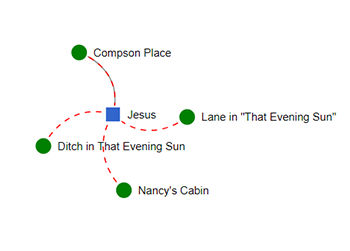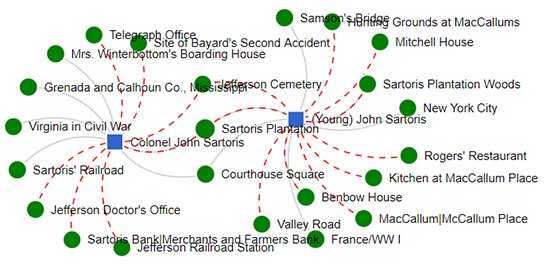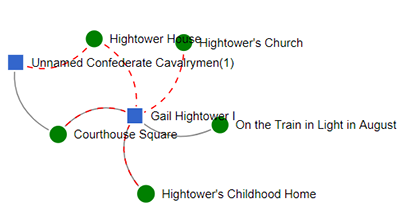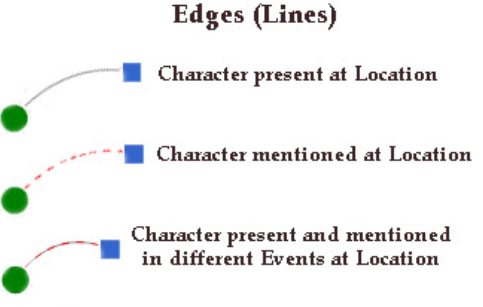Karaman Essay
| CLOSE WINDOW |

|
University of Virginia |
|
QUESTION By way of characters' memories or feelings about someone's presence, ghosts are recalled as a manifestation of the past, of grief, of unrequited desires. But where are they? Are ghosts confined more to the central home of the story? Are they spread out across multiple locations? I'm hoping that these questions might help me better understand Faulkner's use of the Gothic genre and, maybe, how he challenges the traditional Gothic interpretation of a ghost by way of locating them elsewhere besides the central home. Thus, I hope I can also answer: To what extent does the symbol of the "gothic home" in Faulkner's work follow tradition by confining ghosts within the house? WHAT I DID IN DY I worked with all of the novels and shorts we read thus far and searched their invocations of ghosts in the Force Directed Graph. I found the character feature "Vitality" particularly useful for this question. With "That Evening Sun" I found one result for "Alive-ghost."  Nothing was yielded when I selected "Dead-ghost." For Flags in the Dust, I found that Colonel Sartoris and Young John Sartoris were both classified as "Dead-ghost." Colonel Sartoris also came up as "Dead-ghost" in "There Was a Queen".  Then, after a few searches that yielded nothing (As I Lay Dying, The Sound and the Fury, "A Justice"), I found that Gale Hightower I and Unnamed Confederate Cavalrymen showed up as "Dead-ghost" for Light in August.  A small note about the design: The legend key was helpful here because I had some difficulty telling the lines apart. I have somewhat weak vision so this can be explained, but it was a little challenging at times to tell the "present and mentioned" line apart from the "mentioned" line, just because the colors and shapes appeared a little faint to me.  Then I used the Character Search tool. The descriptions were useful as there were specific references to how characters manifested as ghosts. For instance, Jesus' description ends with, "While Jesus directly appears only once, the story is haunted by the possibility of his return." I also found this feature helpful with understanding the history of characters I didn't know, like the unnamed Confederate Cavalrymen in Light in August: "…given the way they continue to ride as phantoms of Hightower's imagination, ‘characters created by another character in the text." What's also useful about these descriptions—especially with regard to my question about the ghosts' locations—is that they offer information on both where the characters first appeared and where their home is, the latter of which was compelling in thinking about where the ghosts "end up" (so to speak). The last tool I used were the audio clips from Faulkner at UVA (http://faulkner.lib.virginia.edu/display/wfaudio24_1#wfaudio24_1.20). They were not critically useful in answering my questions; however, the second to last clip did address Ratliff and how he stands as different from other characters across Faulkner's work. Specifically, Faulkner says that Ratliff "had accepted a - a change in culture, a change in environment, and he has suffered no anguish, no grief from it." I used the force directed graphs to see if Ratliff is attached to a wider array of areas than other characters—maybe this could explain his acceptance of change, and if he has any attachment to ghosts if he also suffers "no anguish, no grief."  Through the character search tool, I found out that Ratliff is one of Faulkner's favorite character. Perhaps the nod towards progression and away from tradition is what lands Ratliff in Faulkner's good graces, and this could help my understanding of which characters are ghosts, which characters are "haunted" by ghosts, and why. INTERPERTIVE CONCLUSIONS Looking at ghosts like Young John Sartoris and Colonel Sartoris, it's interesting to note the vast array of locations their presence is mentioned in. Looking at them as ghosts allows me to also consider how influential their "spirits", their memories, are to the other characters in the novel. Especially in Flags in the Dust, I have a slightly clearer idea of how the deceased are in both the personal past of the Sartoris' and in the cultural past of the South/the Confederacy. For a shorter work like "That Evening Sun" it makes sense that there are only a few locations Jesus is mentioned in, but the fact that he is only mentioned in Nancy's cabin and the surrounding areas (the lane, the ditch) and doesn't make a physical appearance in any of them clues me into how powerful and threatening he is to Nancy—even if he isn't "there." Something else I noticed was how many peripheral characters appeared as "Dead-ghost" and how many of those died in war. Young John Sartoris and the unnamed cavalrymen both die on the peripheries of the narrative yet their presence reverberates into the present setting of the story. For Young John, his home and the central location of Flags in the Dust, the Sartoris Plantation, is plagued with the memories both of the South's loss and of personal, familial loss. In this case, calling Young John "peripheral" would be a major understatement, and I can see why he's given the rank of "Major" character (the "Rank" feature in the character search was helpful here). Even the cavalrymen, who are ranked "peripheral", are historical figures and contribute to the overall Southern gothic obsession with reclaiming the past. As well, the information about Ratliff was cool to learn, albeit I didn't have enough information to make a determination on whether or not he helped my research. I do know that he is distinct and is favored above other characters due to his down to earth nature and willingness to accept cultural progress. I hope we can meet Ratliff somewhere in our future readings so I can get a better idea of how he fits into the narrative of ghosts. The character search tool and the description feature were essential here, and I was pleasantly surprised to find it as handy as I did. I thought that the tie between the ghosts and their locations would tell me more about how Faulkner employs the gothic genre, and to what extent, but that remains somewhat unanswered. There are so many features in DY that show the locations that characters are both "present" and "mentioned" in, but I don't think any of these helped significantly. For someone like Young John Sartoris, the list of locations he's mentioned in is so long and diverse that it wasn't helpful in answering my question, just helpful in showing me how memorable he is to his family and to the town even after death. Then again, I recognize my limitations in not using DY more frequently throughout the semester. Had I tried engaging with it more often, I might have been more comfortable making literary interpretations; that being said, the tool itself was not difficult to navigate and I adapted fairly quickly to using it (about 15-20 minutes of brief browsing). I'm not giving up on the question of ghosts. I would like to examine the many ways in which the past is invoked—ghosts and otherwise. Symbolism has also been on my mind in trying to understand "the past", and if I could work on this project again, I would want to focus on one or two symbols and trace their importance to certain characters and locations. Citing this source: |
